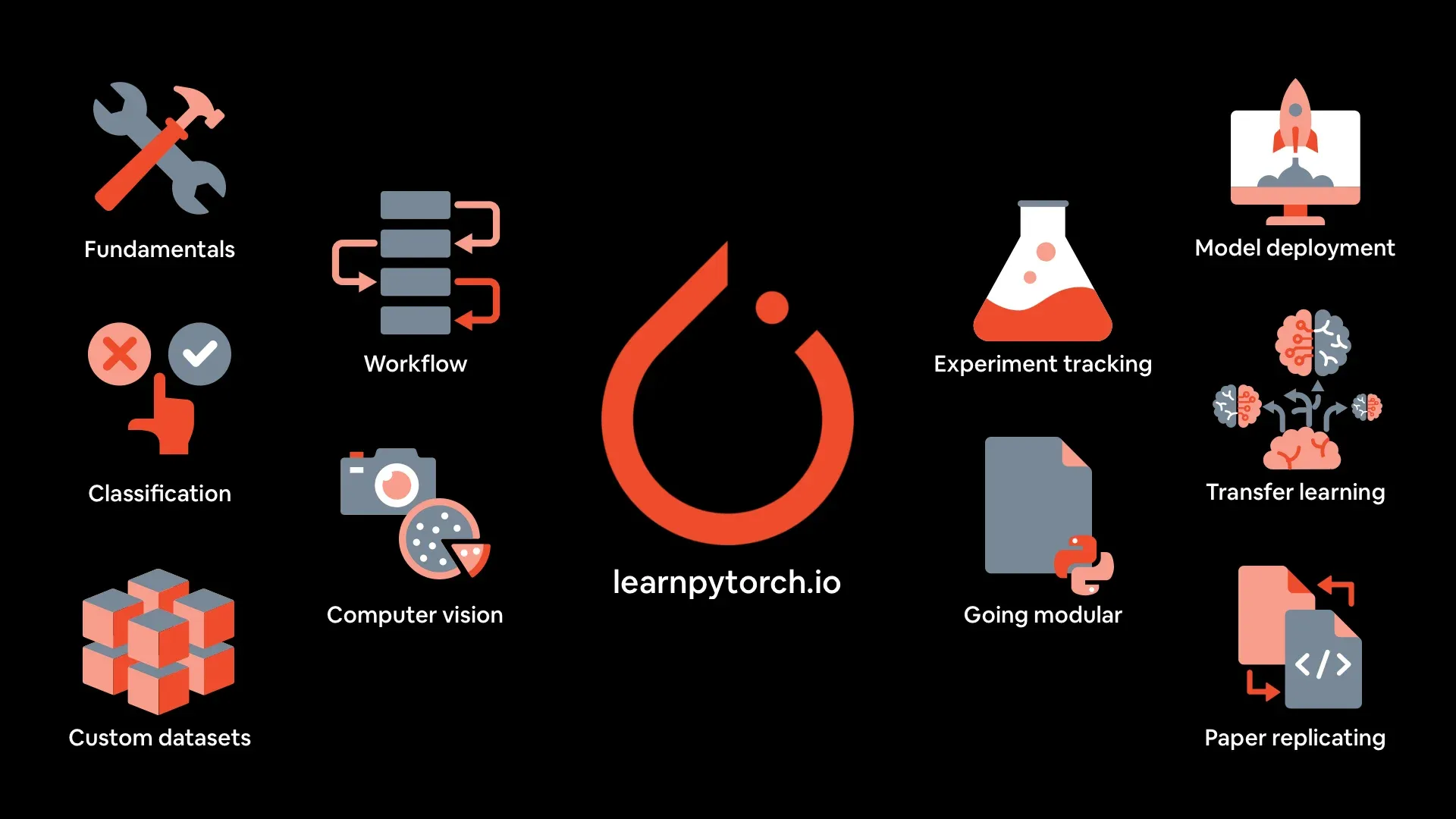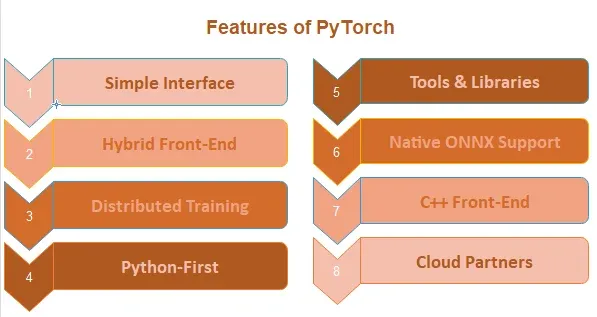PyTorch has emerged as the platform of choice for a growing number of AI developers, thanks to its tailored support for Python-based deep learning research. Simplifying everything from code debugging to model deployment, PyTorch's Pythonic design has driven its widespread adoption with a market share of 21.39%.
Developer teams acclaim PyTorch's ability to accelerate prototyping, cut costs through dynamic computational graphs, modular components, and simplified debugging. These capabilities unlock greater experimentation with innovative neural network designs, making PyTorch indispensable as deep learning tackles increasingly complex real-world challenges.
As global investments in artificial intelligence surge, mastering versatile deep learning frameworks like PyTorch promises to drive tremendous value for enterprises across all sectors. Join us as we delve into why PyTorch has emerged as the premier choice for building the next generation of AI.
Pytorch in Deep Learning

PyTorch is an open-source machine learning library that is widely used in the field of deep learning. It provides a flexible and dynamic approach to building and training neural networks.
With PyTorch, developers can easily design complex deep learning models and algorithms, and efficiently train them on large datasets. It allows for intuitive model development using Python, making it a popular choice among researchers and developers in the deep learning community.
With its computational efficiency and ease of use, PyTorch has become a powerful tool for implementing and experimenting with various deep-learning techniques.
Benefits of Using PyTorch in Deep Learning
PyTorch is known for its ease of use and high-level APIs, making your code more intuitive and readable. It's like having a friendly assistant guiding you through the complex world of deep learning.

1. Automatic Differentiation
Don't you just love it when the heavy lifting is done for you? PyTorch's automatic differentiation lets you focus on designing and training your deep learning models without worrying about the nitty-gritty of calculating gradients.
With PyTorch, you can effortlessly perform backpropagation and update your model's parameters, making your deep learning journey a breeze.
2. Ease of Use and High-Level APIs
Who said deep learning had to be complicated? PyTorch offers a user-friendly interface and high-level APIs that make your code more intuitive and readable.
With PyTorch, you can quickly prototype your models and experiment with different architectures. Whether you're a beginner or a seasoned deep learning expert, PyTorch's ease of use will make you feel right at home.
3. Pythonic Approach
Are you a Python enthusiast? Well, PyTorch is here to join the party! With its Pythonic approach, PyTorch integrates seamlessly with the Python ecosystem.
You can leverage your Python skills and libraries to preprocess data, visualize results, or integrate with other machine-learning tools. PyTorch's intuitive syntax makes writing deep-learning code feel like a piece of cake.
4. Large Community Support
Nobody likes going on a deep learning journey alone. PyTorch comes with an active and vibrant community that's always ready to lend a helping hand.
The PyTorch community offers a plethora of resources, including tutorials, research papers, and pre-trained models. Whether you have a question or want to stay up-to-date with the latest developments, the PyTorch community has got your back.
5. Dynamic Computational Graph
Who needs a static path when you can have flexibility? PyTorch's dynamic computational graph allows you to build models on the fly. You can modify and reshape your computational graph dynamically, making it easier to implement complex architectures and handle varying input sizes. Say goodbye to static computational graphs and embrace the flexibility of PyTorch.
Suggested Reading:
6. High Performance
Speed matters, especially in deep learning. PyTorch is known for its exceptional performance, competing toe-to-toe with top deep learning frameworks.
PyTorch utilizes various optimization techniques and provides support for hardware acceleration, such as GPUs, to squeeze out every ounce of performance. Get ready to train models faster and tackle more challenging problems.
7. Excellent GPU Support
When training deep learning models, you want the power of GPUs on your side. PyTorch offers excellent support for GPUs, harnessing their parallel processing capabilities to accelerate your computations.
With PyTorch's optimized implementation for NVIDIA CUDA and AMD ROCm, you can maximize your GPU resources and elevate your deep learning experience to new heights.
8. Support for Hybrid Front-End Systems
Why limit yourself to one deep learning framework when you can have the best of both worlds? PyTorch plays well with hybrid front-end systems like ONNX and TensorFlow. You can train your models in PyTorch and seamlessly export them to other frameworks for deployment or inference. Enjoy the flexibility of using different tools while keeping all the benefits PyTorch has to offer.
Suggested Reading:
9. Efficient Production-Deployment
What good is a deep learning model if it can't see the light of day? PyTorch makes deploying your trained models to production environments a breeze.
With PyTorch, you can export your models to various deployment formats, such as TorchScript or ONNX, and integrate them into your production pipelines. Say hello to efficient deployment and goodbye to deployment headaches.
10. State-of-the-art Deep Learning Techniques
If you're in pursuit of cutting-edge deep learning techniques, PyTorch has you covered. PyTorch supports a wide range of domains, including computer vision, natural language processing, and audio processing.
With PyTorch, you can leverage state-of-the-art models and techniques, explore the latest research advancements, and stay at the forefront of deep learning innovation.
11. Excellent Documentation and Tutorials
When you embark on a deep learning journey, having reliable resources is crucial. PyTorch offers extensive documentation, tutorials, and examples to guide you through every step of the way. Whether you're a beginner or an advanced practitioner, the PyTorch documentation will provide you with valuable insights, tips, and best practices. Get ready to level up your deep learning skills with PyTorch's wealth of knowledge.
Best Practices and Tips for PyTorch Development
As PyTorch cements itself as the premier framework for deep learning research and development, mastering best practices is key to accelerating workflows. From debugging to production deployment, optimized PyTorch code unlocks faster iteration, reduced costs, and simplified maintenance. Read on as we provide key tips and strategies to maximize productivity and innovation with this versatile AI framework.
Writing Clean and Maintainable PyTorch Code
- Importance of code readability and organization
- Properly naming variables, functions, and classes
- Using comments and docstrings for documentation
- Applying modularization and code reuse techniques
Debugging Techniques for PyTorch Models
- Common debugging strategies for PyTorch
- Utilizing PyTorch's built-in debugging functionalities
- Visualizing model outputs and intermediate representations
- Debugging common issues like vanishing gradients or overfitting
Suggested Reading:
Using PyTorch Lightning for Structured PyTorch Code
- Introduction to PyTorch Lightning
- Benefits of using PyTorch Lightning for structured code
- Simplifying training loops and experiment configurations
- Leveraging built-in features like automatic checkpointing and early stopping
Performance Optimization in PyTorch
- Identifying performance bottlenecks in PyTorch code
- Utilizing PyTorch's parallelization capabilities
- Taking advantage of GPUs for faster computations
- Implementing distributed training for scaling deep learning models
PyTorch Best Practices for Deployment and Productionization
- Exporting PyTorch models for deployment
- Creating efficient inference pipelines using PyTorch
- Utilizing frameworks like Flask for model-serving
- Scaling PyTorch models in production using cloud platforms (AWS, GCP, Azure)
Each of the above headings will be expanded upon in the actual blog content, providing detailed explanations and practical tips for each best practice in PyTorch development.
Conclusion
In conclusion, PyTorch offers a multitude of benefits for deep learning practitioners. From its automatic differentiation and ease of use to its Pythonic approach and large community support, PyTorch provides a user-friendly and intuitive framework to design and train deep learning models.
With its dynamic computational graph and excellent GPU support, PyTorch allows for flexibility and high-performance computing. The compatibility with hybrid front-end systems and efficient production-deployment make PyTorch a versatile choice for deep learning projects.
Additionally, PyTorch enables practitioners to leverage state-of-the-art deep learning techniques and stay at the forefront of innovation. With its excellent documentation and tutorials, PyTorch provides valuable resources for both beginners and advanced practitioners.
Overall, PyTorch empowers deep learning enthusiasts to push the boundaries and unleash their creativity in the world of artificial intelligence.
Suggested Reading:
Frequently Asked Questions (FAQs)
How does PyTorch's automatic differentiation simplify deep learning?
PyTorch's automatic differentiation calculates gradients for you, making it easier to perform backpropagation and update model parameters without diving into complex math.
How does PyTorch harness the power of GPUs?
PyTorch seamlessly integrates with GPUs, leveraging their parallel processing capabilities for faster model training and computation in deep learning tasks.
Can I use PyTorch alongside other deep learning frameworks?
Absolutely! PyTorch plays nicely with hybrid front-end systems like ONNX and TensorFlow, allowing you to train your models in PyTorch and export them for deployment or inference.
What kind of community support can I expect with PyTorch?
PyTorch boasts an active and vibrant community that provides tutorials, research papers, and pre-trained models, ensuring you have resources and assistance throughout your deep learning journey.
How does PyTorch keep up with cutting-edge techniques in deep learning?
PyTorch supports a wide range of domains, allowing you to leverage and explore state-of-the-art models and techniques in computer vision, natural language processing, and more.
Why is PyTorch becoming popular in deep learning?
PyTorch is becoming popular in deep learning due to its dynamic computational graph, flexibility, and ease of use. With PyTorch, users can change model architecture, test different ideas quickly, run code on GPUs efficiently, and manipulate tensors with ease. Moreover, PyTorch is an open-source library with a growing community, which adds to its appeal and has resulted in the development of numerous resources for users to learn and work with the framework.


